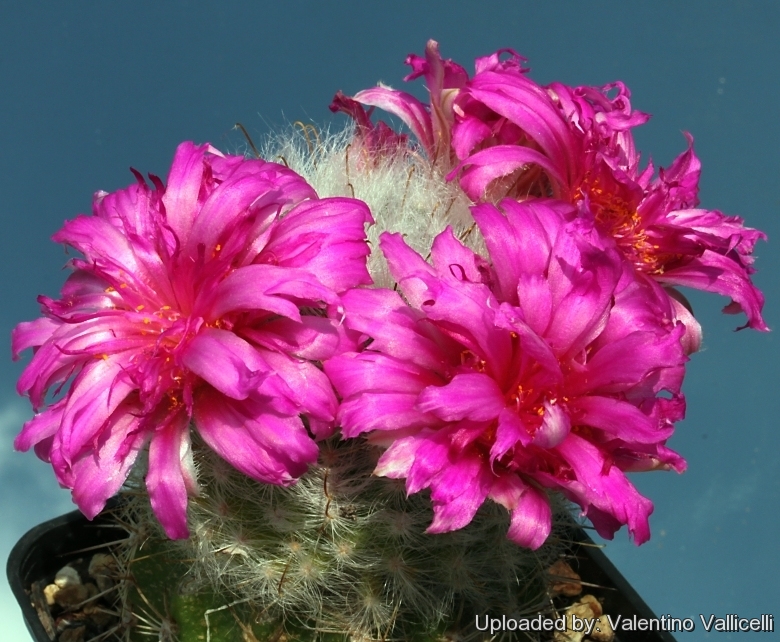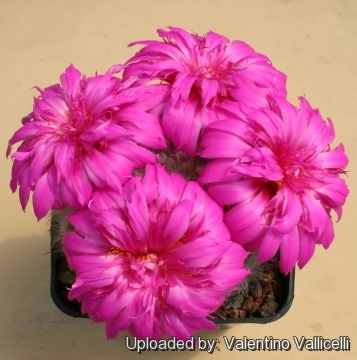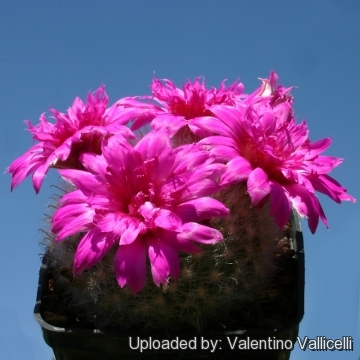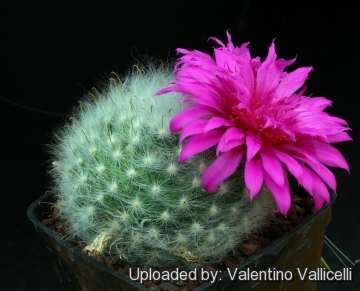Accepted Scientific Name: Mammillaria guelzowiana cv. Double Flower

Mammillaria guelzowiana fl. pl. (Mammillaria guelzowiana cv. Double Flower) Photo by: Valentino Vallicelli
Origin and Habitat: Garden origin (Nursery produced cultivar)
Synonyms:
See all synonyms of Mammillaria guelzowiana
back
Accepted name in llifle Database:Mammillaria guelzowiana Werderm.Z. Sukkulentenk. iii. 356 (1928)Synonymy: 4
Cultivars
(1):
back
Description: Mammillaria guelzowianaSN|17337]]SN|5405]] is a well known species characterized by bright magenta flower about 6 cm in diameter - very large for a Mammillaria! The double-flowered form (Mammillaria guelzowiana cv. Double FlowerSN|5405]]SN|17337]]) - despite to its beauty - is still very rare and sought after by collectors for its unique flower-features among cacti. It is in fact one of the few double-flowerd cacti known, in its flowers some of the stamens are replaced by extra petals giving rise to an extraordinary huge magenta flower.
Habit: It is a soft small solitary or clustering cactus, with the stems obscured by spines.
Stem: Globose depressed apically, 4-10 cm in diameter up to 7 cm high. Without latex.
Tubercles: Conical to cylindrical, flabby. The axil is naked.
Radial spines: 60-80, many white hair-like, with some other tan stiff radials, twisted, smooth, to 15 mm long.
Central spines: 1-6, slender, needle-like, reddish brown to yellow, 8 - 25 mm (0.3 - 1 in) long, one hooked.
Flowers: Bell shaped to broadly funnel-form in which extra petals are present, giving blooms a full or doubled appearance. Bright pink to intense magenta with light scent, to 4 cm long and 7 cm in diameter.
Blooming season: June/July
Subspecies, varieties, forms and cultivars of plants belonging to the Mammillaria guelzowiana group
Notes: Double-flower forms often arise when some or all of the stamens in a flower are replaced by petals. These types of mutations, where one organ in a developing organism is replaced with another, are known as homeotic mutations. The double flower is the result of a specific genetic mutation, one rarely found in the wild. When searching for double-flowerd plants, look in the scientific name for the term "flore pleno", usually abbreviated to "fl. pl.", to indicate that the plant has a double flower. The term comes from the Latin words for “full flowered,” and plants bearing the term may produce at least some double flowers.
Bibliography: Major references and further lectures:
1) James Cullen, Sabina G. Knees, H. Suzanne Cubey "The European Garden Flora Flowering Plants: A Manual for the Identification of Plants Cultivated in Europe, Both Out-of-Doors and Under Glass" Cambridge University Press, 11/Aug/2011
2) Stuart Max Walters “The European garden flora. 3.[Angiospermae], Dicotyledons. [Casuarinaceae to Aristolochiaceae]” Cambridge University Press, 1989
3) Edward Anderson “The Cactus family” Timber Press, Incorporated, 2001
4) Hiroshi Hirao “Colour encyclopaedia of cacti” Seibundo Shinkosha, 1979
5) David R Hunt; Nigel P Taylor; Graham Charles; International Cactaceae Systematics Group. "The New Cactus Lexicon" dh books, 2006
 Mammillaria guelzowiana fl. pl. (Mammillaria guelzowiana cv. Double Flower) Photo by: Valentino Vallicelli
Mammillaria guelzowiana fl. pl. (Mammillaria guelzowiana cv. Double Flower) Photo by: Valentino Vallicelli Mammillaria guelzowiana fl. pl. (Mammillaria guelzowiana cv. Double Flower) Photo by: Valentino Vallicelli
Mammillaria guelzowiana fl. pl. (Mammillaria guelzowiana cv. Double Flower) Photo by: Valentino Vallicelli Mammillaria guelzowiana fl. pl. (Mammillaria guelzowiana cv. Double Flower) Photo by: Valentino Vallicelli
Mammillaria guelzowiana fl. pl. (Mammillaria guelzowiana cv. Double Flower) Photo by: Valentino Vallicelli Mammillaria guelzowiana fl. pl. (Mammillaria guelzowiana cv. Double Flower) Photo by: Cactus Art
Mammillaria guelzowiana fl. pl. (Mammillaria guelzowiana cv. Double Flower) Photo by: Cactus Art Mammillaria guelzowiana fl. pl. (Mammillaria guelzowiana cv. Double Flower) Photo by: Valentino Vallicelli
Mammillaria guelzowiana fl. pl. (Mammillaria guelzowiana cv. Double Flower) Photo by: Valentino Vallicelli Mammillaria guelzowiana fl. pl. (Mammillaria guelzowiana cv. Double Flower) Photo by: Cactus Art
Mammillaria guelzowiana fl. pl. (Mammillaria guelzowiana cv. Double Flower) Photo by: Cactus Art Mammillaria guelzowiana fl. pl. (Mammillaria guelzowiana cv. Double Flower) Photo by: Cactus Art
Mammillaria guelzowiana fl. pl. (Mammillaria guelzowiana cv. Double Flower) Photo by: Cactus Art Mammillaria guelzowiana fl. pl. (Mammillaria guelzowiana cv. Double Flower) Photo by: Valentino Vallicelli
Mammillaria guelzowiana fl. pl. (Mammillaria guelzowiana cv. Double Flower) Photo by: Valentino VallicelliCultivation and Propagation: Cultivation and Propagation: It is one of the more difficult species to grow long enough to produce clumps, but if grown correctly, it will reward the grower with generous displays of purple flowers; plants should be allowed to become crowded in their pot. Keep in shallow pots.
Watering Needs: Need regular water but do not water again until dry as it is specially sensitive to over watering. Also, it is a species that is dormant in the winter and require very little water (maybe even none) during the cold months.
Frost Tolerance: Light frost protection required. Minimum of 5ºC for safe growing (but hardy up to -5°C or less.)
Sun Exposure: High levels of light are needed to flower and for good spine development. Can be sunburned if moved from shade/greenhouse into full sun too quickly. During the spring it may be able to take full sun until the heat arrives at the end of spring. In an area that has hot afternoon sun, it may be able to take full morning sun, but requires afternoon shade or afternoon light shade.
Propagation: Grafting (usually) or offsets that appear at the base; leave them attached to form a cluster, or wait until they are 1/3 the size of the parent and then detach and plant.



















